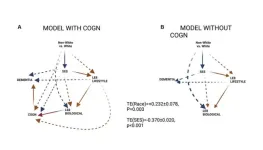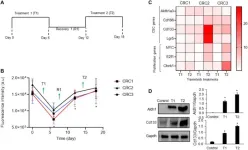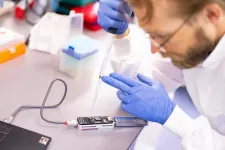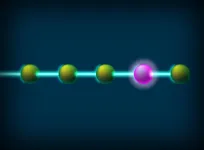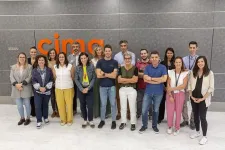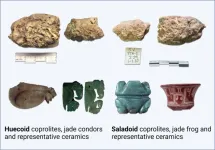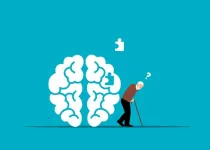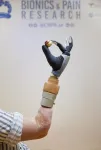(Press-News.org) MINNEAPOLIS – New guidance has been issued for clinicians on the determination of brain death, also known as death by neurologic criteria. A new consensus practice guideline, developed through a collaboration between the American Academy of Neurology (AAN), the American Academy of Pediatrics (AAP), the Child Neurology Society (CNS), and the Society of Critical Care Medicine (SCCM) is published in the October 11, 2023, online issue of Neurology®, the medical journal of the American Academy of Neurology.
This guideline updates the 2010 AAN adult practice guidelines and the 2011 AAP/CNS/SCCM pediatric practice guidelines on the determination of brain death. Because of a lack of high-quality evidence on the subject, the experts used an evidence-informed consensus process to develop the guideline.
“Until now, there have been two separate guidelines for determining brain death, one for adults and one for children,” said author Matthew P. Kirschen, MD, PhD, FAAN, of the Children’s Hospital of Philadelphia, and a member of the Child Neurology Society and the Society of Critical Care Medicine. “This update integrates guidance for adults and children into a single guideline, providing clinicians with a comprehensive and practical way to evaluate someone who has sustained a catastrophic brain injury to determine if they meet the criteria for brain death.”
Brain death is a state in which there is complete and permanent cessation of function of the brain in a person who has suffered catastrophic brain injury.
“Brain death means that clinicians cannot observe or elicit any clinical signs of brain function,” said author David M. Greer, MD, FAAN, FCCM, of Boston University in Massachusetts. “Brain death is different from comatose and vegetative states. People do not recover from brain death. Brain death is legal death.”
The consensus practice guideline outlines the standardized procedure for trained clinicians to evaluate people for brain death. As part of this procedure, clinicians perform an evaluation to determine whether there is any clinical functioning of the brain and brainstem, including whether the person breathes on their own. Brain death is declared if a person has a catastrophic brain injury, has no possibility of recovering any brain function, is completely unresponsive, does not demonstrate any brain or brainstem function, and does not breathe on their own.
This guideline includes updates on the prerequisites for brain death determination, the examination and the examiners, apnea testing and ancillary testing.
As part of the guideline, a digital application has been developed to walk clinicians through the process of brain death determination. It is available for free on AAN.com.
“Right now, brain death determination policies vary among hospitals across the U.S. and worldwide, and a standardized approach is necessary,” said author Ariane Lewis, MD, FAAN, of NYU Langone Medical Center in New York City. “This guideline provides a highly rigorous and structured approach to brain death evaluation and determination. It is recommended that hospital administrators ensure that their hospital’s brain death determination policies are updated to be consistent with this new guideline.”
“The American Academy of Pediatrics appreciates the development of this consensus guideline, which took many hours of careful and evidence-based consideration,” said author Sonia Partap, MD, FAAP, of Stanford University in California. “Any child’s death is never short of devastating. Pediatricians share a special relationship and trust with their patients and this guideline is to ensure we help families walk through the most difficult circumstances.”
“Guidelines should speak to the full community that will be applying them in practice,” said author Lori Shutter, MD, of the University of Pittsburgh in Pennsylvania, and a member of the Society of Critical Care Medicine. “The authorship of this guideline addresses that by including representatives from both academic and community settings and with a wide variety of specialties, including critical care, neurology and pediatrics. This document can guide care across the spectrum of clinical needs.”
The guideline was funded by the American Academy of Neurology.
About the American Academy of Neurology
The American Academy of Neurology is the world’s largest association of neurologists and neuroscience professionals, with over 40,000 members. The AAN is dedicated to promoting the highest quality patient-centered neurologic care. A neurologist is a doctor with specialized training in diagnosing, treating and managing disorders of the brain and nervous system such as Alzheimer’s disease, stroke, migraine, multiple sclerosis, concussion, Parkinson’s disease and epilepsy.
For more information about the American Academy of Neurology, visit AAN.com or find us on Facebook, Twitter, Instagram, LinkedIn and YouTube.
About the American Academy of Pediatrics
The American Academy of Pediatrics is an organization of 67,000 primary care pediatricians, pediatric medical subspecialists and pediatric surgical specialists whose mission is to attain optimal physical, mental, and social health and well-being for all infants, children, adolescents, and young adults. For frequent updates on AAP recommendations, Pediatrics studies, AAP in the news, public awareness campaigns, information for parents and more, follow us on social media @AmerAcadPeds or go to AAP.org.
For parent-friendly health information from the AAP, visit www.HealthyChildren.org.
About the Child Neurology Society
The Child Neurology Society (CNS) is the professional home of physicians specializing in pediatric neurology from the U.S., Canada, and around the world. Founded in 1972 — just three years after the American Board of Psychiatry and Neurology awarded the first board certification in neurology with special qualifications in child neurology — the society’s mission is to connect pediatric neurologists and advance the field of child neurology through education, collaboration, and mentorship. With nearly 3,000 members worldwide, CNS stands on the belief that every member counts because every child counts. To learn more, visit childneurologysociety.org.
About the Society of Critical Care Medicine
The Society of Critical Care Medicine (SCCM) is the largest nonprofit medical organization dedicated to promoting excellence and consistency in the practice of critical care. With members in more than 80 countries, SCCM is the only organization that represents all professional components of the critical care team. SCCM’s Critical Care Congress brings together intensivists and critical care experts from around the world to share the latest scientific research, develop solutions to common issues, and improve the care of critically ill and injured patients. For more information on SCCM, visit sccm.org or follow SCCM on LinkedIn, Facebook, Twitter (X), and YouTube.
END
New guidance issued on the determination of brain death
AAN, AAP, CNS and SCCM develop consensus practice guideline
2023-10-11
ELSE PRESS RELEASES FROM THIS DATE:
Insights on disparities in dementia from the UK Biobank study
2023-10-11
“The present study is among few to examine racial/ethnic disparities in dementia risk and their related pathways [...]. It is the first to do so in a UK population.”
BUFFALO, NY- October 11, 2023 – A new research paper was published in Aging (listed by MEDLINE/PubMed as "Aging (Albany NY)" and "Aging-US" by Web of Science) Volume 15, Issue 18, entitled, “Pathways explaining racial/ethnic and socio-economic disparities in dementia incidence: the UK Biobank study.”
Pathways explaining racial/ethnic disparities ...
Suppression of cancer stemness and drug resistance via BRAF/EGFR/MEK inhibition in colorectal cancer cells
2023-10-11
“[...] our approach enables mechanistic studies of drug resistance with 3D cultures of primary cancer cells to develop and test treatments that suppress cancer [...].”
BUFFALO, NY- October 11, 2023 – A new research paper was published in Oncotarget's Volume 14 on October 4, 2023, entitled, “Inhibiting BRAF/EGFR/MEK suppresses cancer stemness and drug resistance of primary colorectal cancer cells.”
Drug resistance is a major barrier against successful treatments of cancer patients. Gain of stemness under drug pressure is a major mechanism that renders treatments ineffective. Identifying ...
Epiphytes, amazing plants like moss and bromeliads found in trees, face growing threats
2023-10-11
Orchids, mosses, ferns—or epiphytes, defined as nonparasitic plants that grow on other plants—are crucial for Earth’s biodiversity and play essential roles in forests around the world, building habitat in trees for myriad other life forms, from bacteria and insects to birds and reptiles.
However, the very attributes that have enabled epiphytes to thrive in forest canopies are now making them vulnerable to both natural and human-caused disturbances, according to Nalini Nadkarni, the University of Utah biologist renowned for her pioneering work studying and conserving treetop ecosystems.
In a study published this month, Nadkarni found these vital plants ...
AI speeds up identification brain tumor type
2023-10-11
What type of brain tumor does this patient have? AI technology helps to determine this as early as during surgery, within 1.5 hours. This process normally takes a week. The new technology allows neurosurgeons to adjust their surgical strategies on the spot. Today, researchers from UMC Utrecht and researchers, pathologists and neurosurgeons from the Princess Máxima Center for pediatric oncology and Amsterdam UMC have published about this study in Nature.
Every year, 1,400 adults and 150 children are diagnosed with a tumor in the brain or spinal cord in the Netherlands. Surgery is often the ...
A new way to erase quantum computer errors
2023-10-11
Quantum computers of the future hold promise in solving all sorts of problems. For example, they could lead to more sustainable materials, new medicines, and even crack the hardest problems in fundamental physics. But compared to classical computers in use today, rudimentary quantum computers are more prone to errors. Wouldn't it be nice if researchers could just take out a special quantum eraser and get rid of the mistakes?
Reporting in the journal Nature, a group of researchers led by Caltech is among the first to demonstrate a type of quantum eraser. The physicists show that they can pinpoint and correct for mistakes in quantum computing ...
Blocking an immune molecule reduces tumor growth and prolongs survival in animal models of the most aggressive childhood cancer
2023-10-11
Researchers from Cima and the Clínica Universidad de Navarra, together with the international cooperative group Diffuse Midline Glioma (DMG-ACT), have confirmed that blocking an immune checkpoint molecule reduces the tumor and prolongs survival in animal models of the most aggressive childhood cancer. This research, carried out at the Cancer Center Clínica Universidad de Navarra, shows that inhibition of TIM-3 promotes the immune memory of diffuse intrinsic stem glioma (DIPG) and improves the prognosis of the disease.
DIPG is an aggressive brain stem tumor and the leading cause of death related to pediatric cancer. Due to its location therapeutic ...
Mummified poop reveals pre-Columbian cultures of the Caribbean consumed a diversity of plants, with peanuts, papaya, maize, and even cotton and tobacco detected
2023-10-11
DNA analysis of mummified poop reveals two pre-Columbian Caribbean cultures ate a wide variety of plants, like maize, sweet potato, and peanuts—and tobacco and cotton traces were detected too, according to a study published October 11, 2023 in the open-access journal PLOS ONE by Jelissa Reynoso-García from the University of Puerto Rico, Puerto Rico, and colleagues.
Mummified poop, or coprolites, can reveal clues to diet and lifestyle. In this study, Reynoso-García and colleagues analyzed plant DNA isolated from coprolites sampled from archeological sites of two pre-Columbian cultures (Huecoid and Saladoid) to see what these peoples ate ...
Risk factors for dementia vary by ethnicity, study finds
2023-10-11
Modifiable risk factors—including hypertension, obesity, diabetes, low HDL cholesterol and sleep disorders—confer a higher risk of dementia for people in some minority ethnic groups compared to White people, according to a new study published this week in the open-access journal PLOS ONE by Naaheed Mukadam of University College London, UK, and colleagues.
The number of people with dementia is on the rise around the world. There has been increasing interest in potentially modifiable risk factors, ...
Study links selfies to higher ratings of slimness
2023-10-11
In a new study, participants tended to rate women’s bodies as slimmer when viewed in selfie photographs than in photographs taken from other angles. Ruth Knight of York St John University, UK, and Catherine Preston of the University of York, UK, present these findings in the open-access journal PLOS ONE on October 11.
Popular on social media, selfies are portraits taken by the photo’s subject, who positions the camera away from their body but pointed back at themself. Prior research has suggested that viewing selfies might affect viewers’ judgments of the photo subjects’ attractiveness and could, in some cases, lead to ...
Groundbreaking achievement as bionic hand merges with user’s nervous and skeletal systems, remaining functional after years of daily use
2023-10-11
Karin's life took a dramatic turn when a farming accident claimed her right arm over 20 years ago. Since then, she endured excruciating phantom limb pain. “It felt like I constantly had my hand in a meat grinder, which created a high level of stress and I had to take high doses of various painkillers.” In addition to her intractable pain, she found that conventional prostheses were uncomfortable and unreliable, and thus of little help in daily life. All this changed when she received groundbreaking bionic technology that allowed her to wear a much more functional ...
LAST 30 PRESS RELEASES:
Making lighter work of calculating fluid and heat flow
Normalizing blood sugar can halve heart attack risk
Lowering blood sugar cuts heart attack risk in people with prediabetes
Study links genetic variants to risk of blinding eye disease in premature infants
Non-opioid ‘pain sponge’ therapy halts cartilage degeneration and relieves chronic pain
AI can pick up cultural values by mimicking how kids learn
China’s ecological redlines offer fast track to 30 x 30 global conservation goal
Invisible indoor threats: emerging household contaminants and their growing risks to human health
Adding antibody treatment to chemo boosts outcomes for children with rare cancer
Germline pathogenic variants among women without a history of breast cancer
Tanning beds triple melanoma risk, potentially causing broad DNA damage
Unique bond identified as key to viral infection speed
Indoor tanning makes youthful skin much older on a genetic level
Mouse model sheds new light on the causes and potential solutions to human GI problems linked to muscular dystrophy
The Journal of Nuclear Medicine ahead-of-print tip sheet: December 12, 2025
Smarter tools for peering into the microscopic world
Applications open for funding to conduct research in the Kinsey Institute archives
Global measure underestimates the severity of food insecurity
Child survivors of critical illness are missing out on timely follow up care
Risk-based vs annual breast cancer screening / the WISDOM randomized clinical trial
University of Toronto launches Electric Vehicle Innovation Ontario to accelerate advanced EV technologies and build Canada’s innovation advantage
Early relapse predicts poor outcomes in aggressive blood cancer
American College of Lifestyle Medicine applauds two CMS models aligned with lifestyle medicine practice and reimbursement
Clinical trial finds cannabis use not a barrier to quitting nicotine vaping
Supplemental nutrition assistance program policies and food insecurity
Switching immune cells to “night mode” could limit damage after a heart attack, study suggests
URI-based Global RIghts Project report spotlights continued troubling trends in worldwide inhumane treatment
Neutrophils are less aggressive at night, explaining why nighttime heart attacks cause less damage than daytime events
Menopausal hormone therapy may not pose breast cancer risk for women with BRCA mutations
Mobile health tool may improve quality of life for adolescent and young adult breast cancer survivors
[Press-News.org] New guidance issued on the determination of brain deathAAN, AAP, CNS and SCCM develop consensus practice guideline
